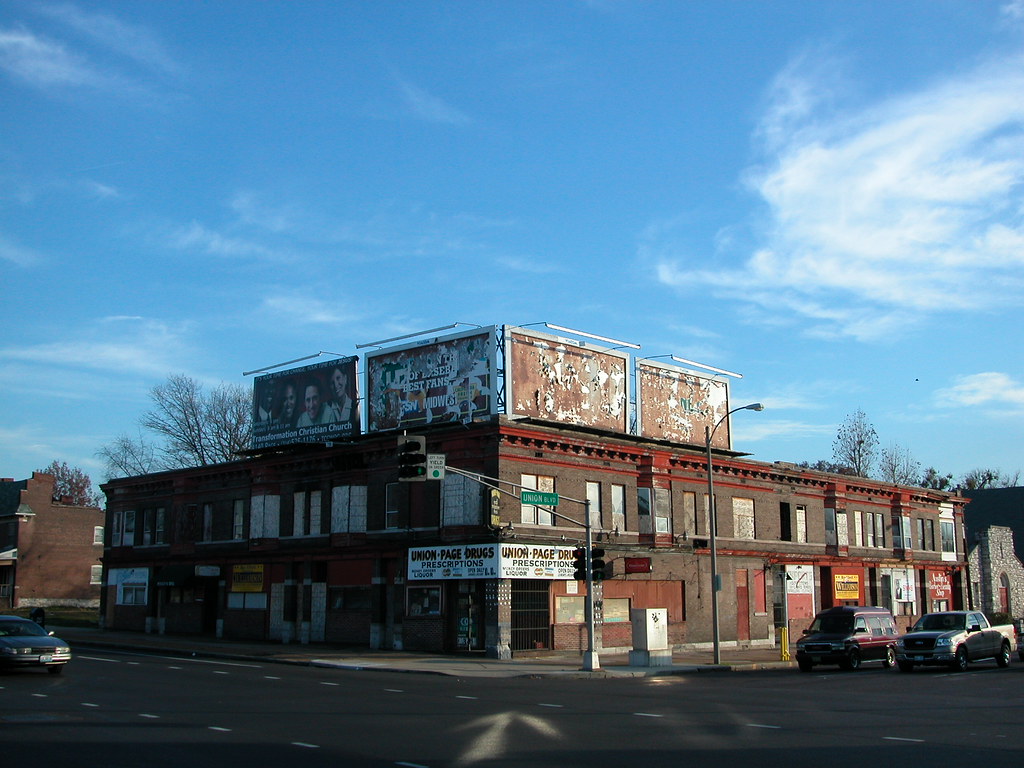by Michael R. Allen

At Monday’s meeting of the St. Louis Preservation Board, the Board voted 3-2 to defer consideration of an appeal of the staff denial of a demolition permit for the building at 5286-92 Page Boulevard. The applicant is the Berean Seventh Day Adventist Church; background on the permit can be found in a post that I made in November. While the November meeting of the Board that considered the matter was packed with congregation members, this month only attorneys William Kuehling and Robert Kinney from Polsinelli Shalton Flanigan Suelthaus appeared to present the church’s case — and yet another rendering of a supposed new building that will replace the existing building (but for which no funds or construction blueprints exist).
Voting to defer the matter were Anthony Robinson, who wanted to hear from the Academy Neighborhood neighborhood association on the proposed new building, Mary Johnson and Alderman Terry Kennedy. Voting against deferral were Mike Killeen and David Richardson. Consideration of the new building is not germane to the Preservation Board’s consideration, which legally applies only to the demolition itself. The building is not located in a local historic district with design guidelines. Instead, it is part of a national historic district where the Board can review demolition permits alone.
Among those who testified in opposition to the demolition was historian Lynn Josse, who wrote the National Register nomination for the Mount Cabanne-Raymond Place Historic District in which this building is a contributing resource and visual anchor. Her words appear here:
By way of background: In 2000, the City of St. Louis funded a National Register nomination in order to protect the Mount Cabanne/Raymond Place Historic District and to encourage the reuse of its valuable historic buildings. The district is listed not only for its architectural merit, which is obvious in this building, but as an example of a compact walkable neighborhood with a distinctly Orthodox Jewish character. The congregation of the B’Nai Amoona synagogue at Academy and Vernon had to live within walking distance of where they worshipped because of Sabbath restrictions, so there was a higher than average concentration of Jewish households and businesses. In most ways though, the neighborhood was like other streetcar neighborhoods of the time. Raymond Place had most of the amenities families needed for daily life within easy walking distance. The building that you’re considering today, by the 1920s was the home of grocery stores, drug stores, a medical office, and a delicatessen – all of which would be vital to the daily life of the neighborhood.
In a district like Mount Cabanne-Raymond Place, it is all too easy to allow the commercial edges to erode and slip away. In this district, we’ve lost at least one of the commercial buildings on Delmar since the listing in 2002. But historically, it is the commercial buildings like this one that made the residential life in the center of the neighborhood possible. Raymond Place boasts a really great collection of architecturally interesting houses, but without the context provided by important commercial buildings like this one, it is just that: a collection of dwellings. Cities are more than that; they are a complex system of people and jobs and transit and housing and recreation and institutions and services and retail. We are doing a good job encouraging reuse of housing, but the neighborhood doesn’t make historic sense and may be less sustainable in the future if you allow the destruction of the small-scale retail spaces that historically have connected people.
Part of what the ordinance directs you to consider is the contribution to the streetscape. This building is the streetscape. For over a hundred years it has defined the corner of Page and Union. Its loss would cause a major gap at the northwest corner of the historic district. Replacing this building with a surface parking lot would be a terrible disservice to the neighborhood. It’s a bad use of land and a terrible waste of an important building that should, according to all of your legal criteria, be preserved.



